Compression Properties and Electrical Conductivity of In-Situ 20 vol.% Nano-Sized TiCx/Cu Composites with Different Particle Size and Morphology
Abstract
:1. Introduction
2. Experimental Procedure
3. Results and Discussion
4. Conclusions
Acknowledgments
Author Contributions
Conflicts of Interest
References
- Qiu, F.; Chu, J.G.; Hu, W.; Lu, J.B.; Li, X.D.; Han, Y.; Jiang, Q.C. Study of effect of Zr addition on the microstructures and mechanical properties of (TiCx–TiB2)/Cu composites by combustion synthesis and hot press consolidation in the Cu–Ti–B4C–Zr system. Mater. Res. Bull. 2015, 70, 167–172. [Google Scholar] [CrossRef]
- Shojaeepour, F.; Abachi, P.; Purazrang, K.; Moghanian, A.H. Production and properties of Cu/Cr2O3 nano-composites. Powder Technol. 2012, 222, 80–84. [Google Scholar] [CrossRef]
- Akhtar, F.; Askari, S.J.; Shah, K.A.; Du, X.L.; Guo, S.J. Microstructure, mechanical properties, electrical conductivity and wear behavior of high volume TiC reinforced Cu-matrix composites. Mater. Charact. 2009, 60, 327–366. [Google Scholar] [CrossRef]
- Liu, Q.; He, X.B.; Ren, S.B.; Liu, T.T.; Kang, Q.P.; Qu, X.H. Fabrication and thermal conductivity of copper matrix composites reinforced with Mo2C or TiC coated graphite fiber. Mater. Res. Bull. 2013, 48, 4811–4817. [Google Scholar] [CrossRef]
- Rahaei, M.B.; Yazdanirad, R.; Kazemzadeh, A.; Ebadzadeh, T. Mechanochemical synthesis of nano TiC powder by mechanical milling of titanium and graphite powders. Powder Technol. 2012, 217, 369–376. [Google Scholar] [CrossRef]
- Yang, Y.F.; Mu, D.K.; Jiang, Q.C. A simple route to fabricate TiC-TiB2/Ni composite via thermal explosion reaction assisted with external pressure in air. Mater. Chem. Phys. 2014, 143, 480–485. [Google Scholar] [CrossRef]
- Qiu, F.; Han, Y.; Cheng, A.; Lu, J.B.; Jiang, Q.C. Effect of Cr Content on the Compression Properties and Abrasive Wear Behavior of the High-Volume Fraction (TiC–TiB2)/Cu Composites. Acta Metall. Sin. 2014, 27, 951–956. [Google Scholar] [CrossRef]
- Acharya, S.; Debata, M.; Acharya, T.S.; Acharya, P.P.; Singh, S.K. Influence of nickel boride addition on sintering behaviour and mechanical properties of TiC-Ni based cermets. J. Alloys Compd. 2016, 685, 905–912. [Google Scholar] [CrossRef]
- Klinger, L.; Gotman, I.; Horvitz, D. In-situ processing of TiB2/TiC ceramic composites by thermal explosion under pressure: Experimental study and modeling. Mater. Sci. Eng. A 2001, 302, 92–99. [Google Scholar] [CrossRef]
- Yang, Y.F.; Jiang, Q.C. Reaction behaviour, microstructure and mechanical properties of TiC–TiB2/Ni composite fabricated by pressure assisted self-propagating high-temperature synthesis in air and vacuum. Mater. Des. 2013, 49, 123–129. [Google Scholar] [CrossRef]
- Shu, S.L.; Yang, H.Y.; Tong, C.Z.; Qiu, F. Fabrication of TiCx-TiB2/Al Composites for Application as a Heat Sink. Materials 2016, 9, 642. [Google Scholar] [CrossRef]
- Li, W.J.; Tu, R.; Goto, T. Preparation of directionally solidified TiB2–TiC eutectic composites by a floating zone method. Mater. Lett. 2006, 60, 839–843. [Google Scholar] [CrossRef]
- Lee, J.W.; Munir, Z.A.; Ohyanagi, M. Dense nanocrystalline TiB2-TiC composites formed by field activation from high-energy ball milled reactants. Mater. Sci. Eng. A 2012, 325, 221–227. [Google Scholar] [CrossRef]
- Aminikia, B. Investigation of the pre-milling effect on synthesis of nanocrystalline TiB2–TiC composite prepared by SHS method. Powder Technol. 2012, 232, 78–86. [Google Scholar] [CrossRef]
- Zhao, Q.; Liang, Y.H.; Zhang, Z.H.; Li, X.J.; Ren, L.Q. Study on the Impact Resistance of Bionic Layered Composite of TiC-TiB2/Al from Al-Ti-B4C System. Materials 2016, 9, 708. [Google Scholar] [CrossRef]
- Popov, V.A.; Shelekhov, E.V.; Prosviryakov, A.S.; Presniakov, M.Y.; Senatulin, B.R.; Kotov, A.D.; Khomutov, M.G. Particulate metal matrix composites development on the basis of in situ synthesis of TiC reinforcing nanoparticles during mechanical alloying. J. Alloys Compd. 2017, 707, 365–370. [Google Scholar] [CrossRef]
- Jin, S.B.; Shen, P.; Zou, B.L.; Jiang, Q.C. Morphology Evolution of TiCx Grains during SHS in an Al-Ti-C System. Cryst. Growth Des. 2009, 9, 646–649. [Google Scholar] [CrossRef]
- Yang, Y.F.; Wang, H.Y.; Wang, J.G.; Jiang, Q.C. TiB2 and TiC stainless steel matrix composites Effect of C particle size on the mechanism of self-propagation high-temperature synthesis in the Ni–Ti–C system. J. Alloys Compd. 2011, 509, 7060–7065. [Google Scholar] [CrossRef]
- Zhou, D.S.; Qiu, F.; Wang, H.Y.; Jiang, Q.C. Manufacture of Nano-Sized Particle-Reinforced Metal Matrix Composites: A Review. Acta Metall. Sin. Engl. Lett. 2014, 27, 798–805. [Google Scholar] [CrossRef]
- Liang, Y.H.; Han, Z.W.; Li, X.J.; Zhang, Z.H.; Ren, L.Q. Study on the reaction mechanism of self-propagating high-temperature synthesis of TiC in the Cu–Ti–C system. Mater. Chem. Phys. 2012, 137, 200–206. [Google Scholar] [CrossRef]
- Liang, Y.H.; Zhao, Q.; Zhang, Z.H.; Li, X.J.; Ren, L.Q. Effect of B4C Particle Size on the Reaction Behavior of Self-Propagation High-Temperature Synthesis of TiC–TiB2 Ceramic/Cu Composites from a Cu–Ti–B4C System. Int. J. Refract. Met. Hard Mater. 2014, 46, 71–79. [Google Scholar] [CrossRef]
- Lu, J.B.; Shu, S.L.; Qiu, F.; Wang, Y.W.; Jiang, Q.C. Compression properties and abrasive wear behavior of high volume fraction TiCx–TiB2/Cu composites fabricated by combustion synthesis and hot press consolidation. Mater. Des. 2012, 40, 157–162. [Google Scholar] [CrossRef]
- Liang, Y.H.; Zhao, Q.; Li, X.J.; Zhang, Z.H.; Ren, L.Q. Effect of Ti and C particle size on reaction behavior of thermal explosion (TE) reaction of Cu-Ti-C system under Ar and air atmosphere. J. Alloys Compd. 2016, 679, 65–73. [Google Scholar] [CrossRef]
- Wang, L.; Qiu, F.; Ouyang, L.C.; Wang, H.Y.; Zha, M.; Shu, S.L.; Zhao, Q.L.; Jiang, Q.C. A Novel Approach of Using Ground CNTs as the Carbon Source to Fabricate Uniformly Distributed Nano-Sized TiCx/2009Al Composites. Materials 2015, 8, 8839–8849. [Google Scholar] [CrossRef]
- Wang, L.; Qiu, F.; Zhao, Q.L.; Wang, H.Y.; Yang, D.L.; Jiang, Q.C. Simultaneously increasing the elevated-temperature tensile strength and plasticity of in situ nano-sized TiCx/Al-Cu-Mg composites. Mater. Charact. 2017, 125, 7–12. [Google Scholar] [CrossRef]
- Kampe, S.L.; Christodoulou, J.; Feng, C.R.; Christodoulou, L.; Michel, D.J. Effect of matrix microstructure and reinforcement shape on the creep deformation of near–γ titanium aluminide composites. Acta Mater. 1998, 46, 2881–2894. [Google Scholar] [CrossRef]
- Chen, C.R.; Qin, S.Y.; Li, S.X.; Li, S.X.; Wen, J.L. Finite element analysis about effects of particle morphology on mechanical response of composites. Mater. Sci. Eng. A 2000, 278, 96–105. [Google Scholar] [CrossRef]
- Xuan, Q.Q.; Shu, S.L.; Qiu, F.; Jin, S.B.; Jiang, Q.C. Different strain-rate dependent compression properties and work-hardening capacities of 50 vol% TiCx/Al and TiB2/Al composites. Mater. Sci. Eng. A 2012, 538, 335–339. [Google Scholar] [CrossRef]
- Nie, J.F.; Wang, F.; Li, Y.S.; Cao, T.; Liu, X.F.; Zhao, Y.H.; Zhu, Y.T. Microstructure Evolution and Mechanical Properties of Al-TiB2/TiC In Situ Aluminum-Based Composites during Accumulative Roll Bonding (ARB) Process. Materials 2017, 10, 109. [Google Scholar] [CrossRef]
- Yu, H.C.; Wang, H.Y.; Chen, L.; Zha, M.; Wang, C.; Li, C.; Jiang, Q.C. Spheroidization of primary Mg2Si in Al-20Mg2Si-4.5Cu alloy modified with Ca and Sb during T6 heat treatment process. Mater. Sci. Eng. A 2017, 685, 31–38. [Google Scholar] [CrossRef]
- Wang, L.; Qiu, F.; Shu, S.L.; Zhao, Q.L.; Jiang, Q.C. Effects of different carbon sources on the compressive properties of in situ high-volume-fraction TiCx/2009Al composites. Powder Metall. 2016, 59, 370–375. [Google Scholar] [CrossRef]
- Meijer, G.; Ellyin, F.; Xia, Z. Aspects of residual thermal stress/strain in particle reinforced metal matrix composites. Compos. Part B Eng. 2000, 31, 29–37. [Google Scholar] [CrossRef]
- Zhou, D.S.; Jin, S.B.; Li, Y.J.; Qiu, F.; Deng, F.; Wang, J.G.; Jiang, Q.C. Effect of stoichiometry on the surface energies of {100} and {111} and the crystal shape of TiCx and TiNx. CrystEngComm 2013, 15, 643–649. [Google Scholar] [CrossRef]
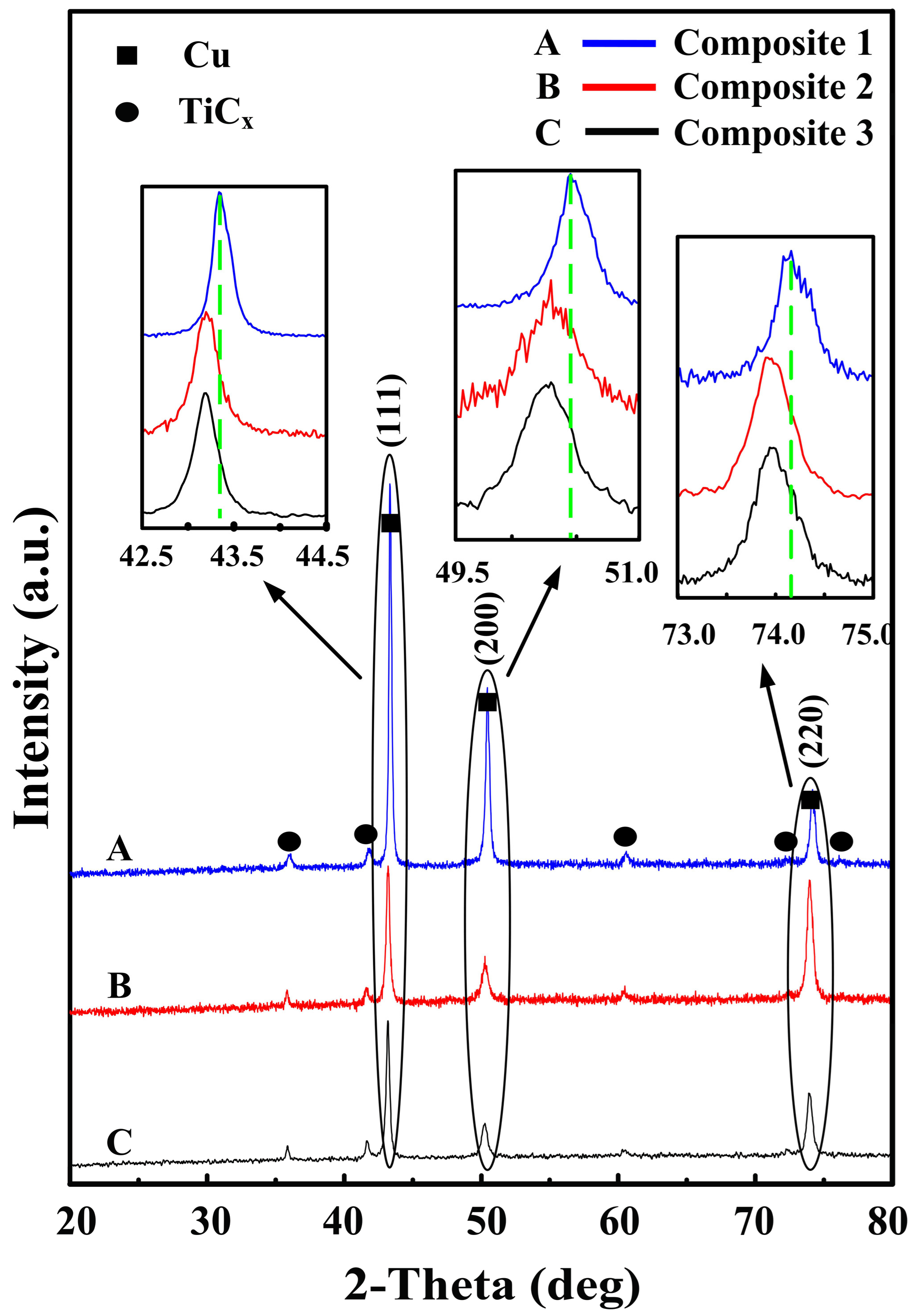
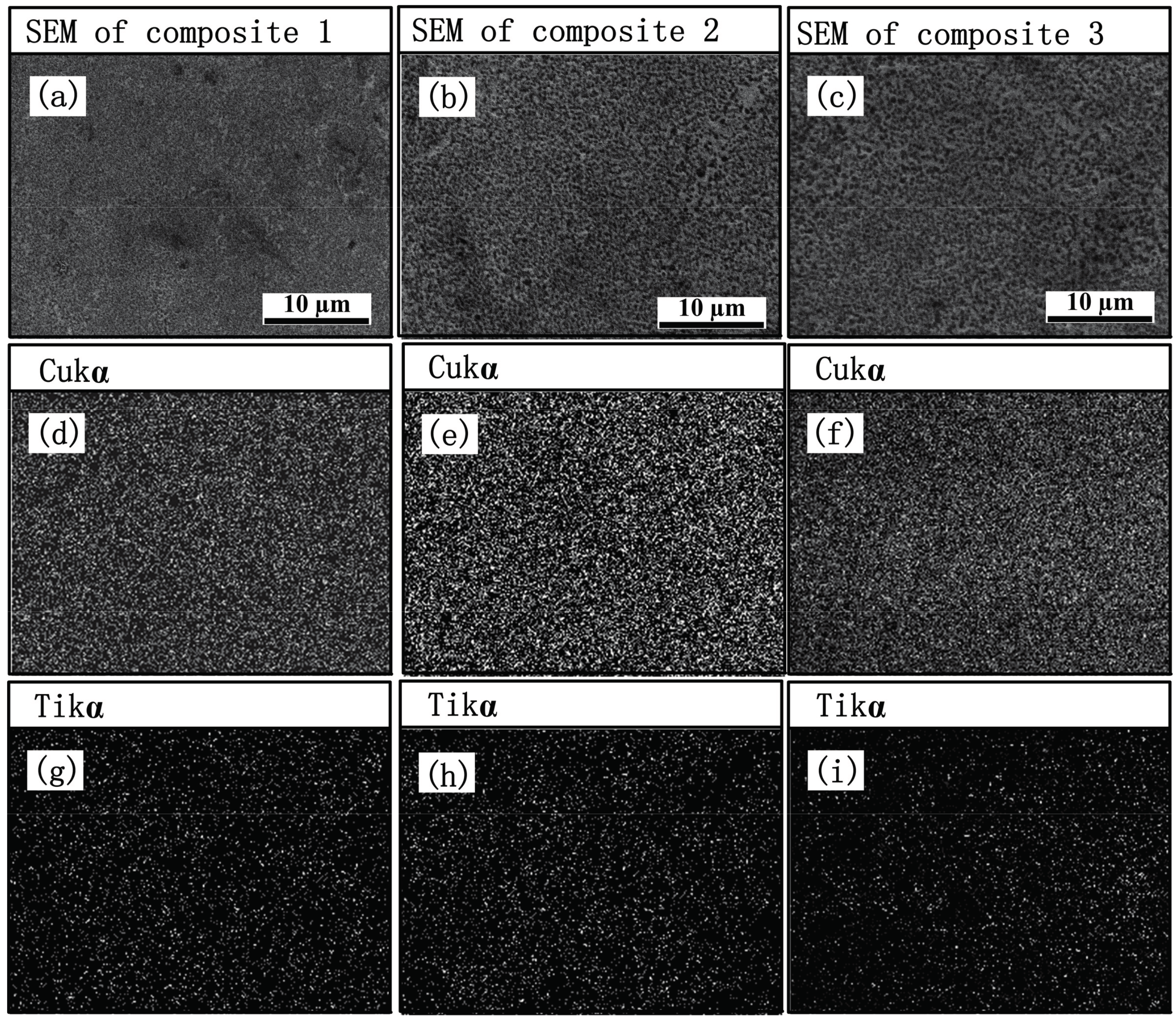
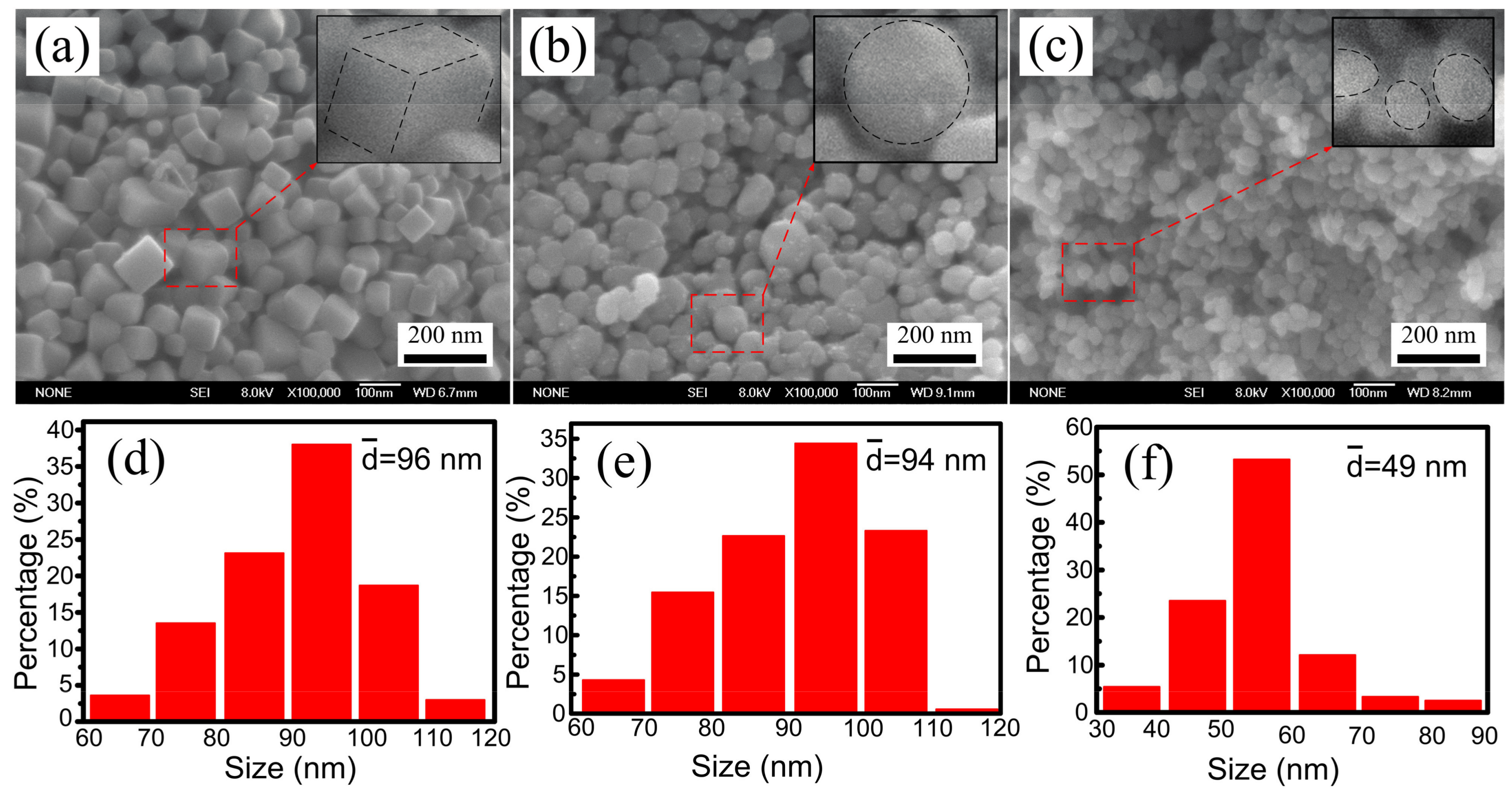
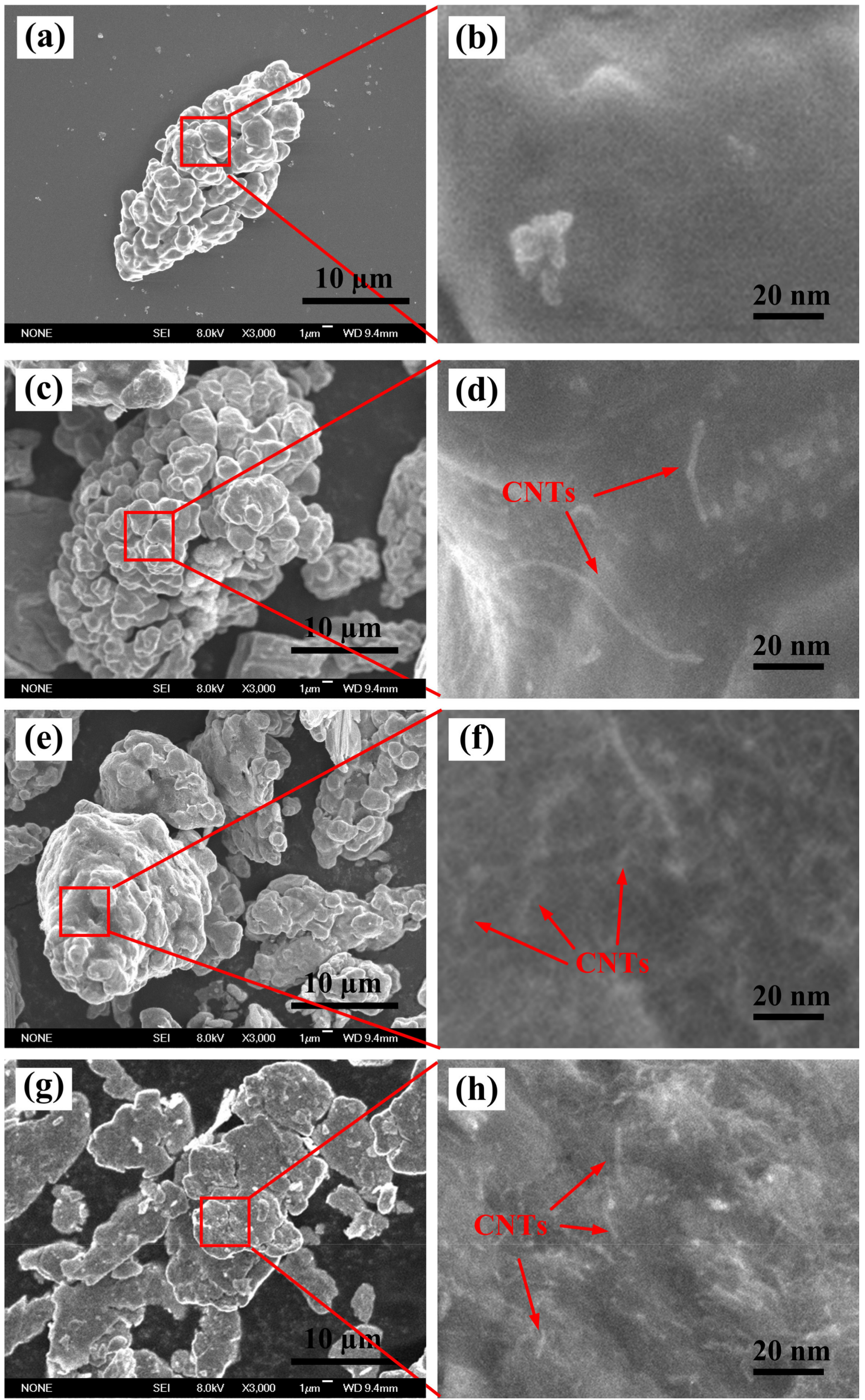
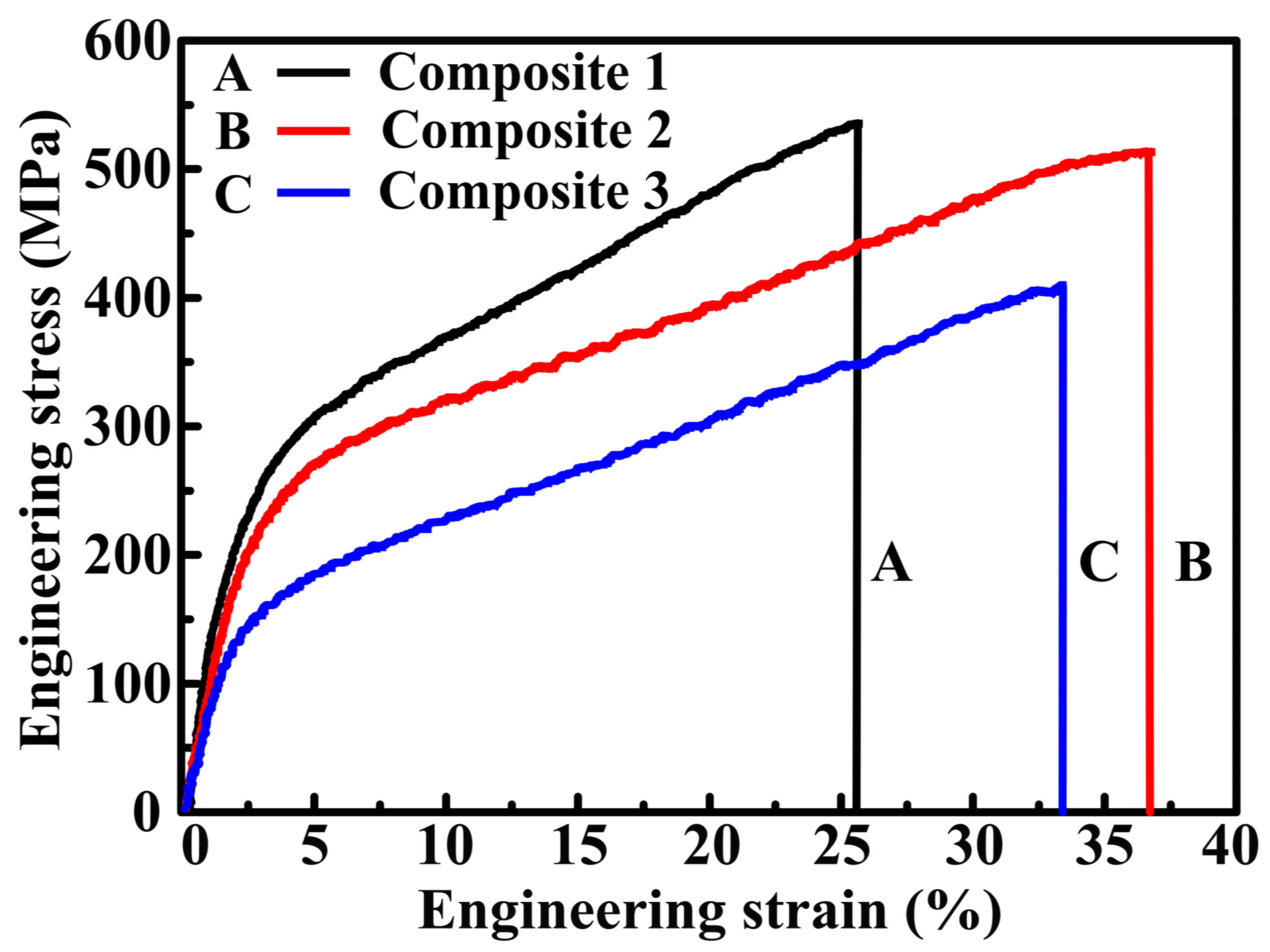


| Composites | Carbon Source | Pre-Milled | Mixed Powders |
|---|---|---|---|
| Composite 1 | raw CNTs | – | raw CNTs + Cu + Ti |
| Composite 2 | ground CNTs | – | ground CNTs + Cu + Ti |
| Composite 3 | ground CNTs | ground CNTs + Cu | Pre-milled + Ti |
| Composites | σ0.2/MPa | σUCS/MPa | ɛf/% |
|---|---|---|---|
| Composite 1 | |||
| Composite 2 | |||
| Composite 3 |
© 2017 by the authors. Licensee MDPI, Basel, Switzerland. This article is an open access article distributed under the terms and conditions of the Creative Commons Attribution (CC BY) license (http://creativecommons.org/licenses/by/4.0/).
Share and Cite
Zhang, D.; Bai, F.; Sun, L.; Wang, Y.; Wang, J. Compression Properties and Electrical Conductivity of In-Situ 20 vol.% Nano-Sized TiCx/Cu Composites with Different Particle Size and Morphology. Materials 2017, 10, 499. https://doi.org/10.3390/ma10050499
Zhang D, Bai F, Sun L, Wang Y, Wang J. Compression Properties and Electrical Conductivity of In-Situ 20 vol.% Nano-Sized TiCx/Cu Composites with Different Particle Size and Morphology. Materials. 2017; 10(5):499. https://doi.org/10.3390/ma10050499
Chicago/Turabian StyleZhang, Dongdong, Fang Bai, Liping Sun, Yong Wang, and Jinguo Wang. 2017. "Compression Properties and Electrical Conductivity of In-Situ 20 vol.% Nano-Sized TiCx/Cu Composites with Different Particle Size and Morphology" Materials 10, no. 5: 499. https://doi.org/10.3390/ma10050499





